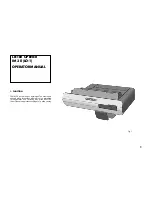
61
BlueShadow Detector 40D Instructions V7647
12. Chemical compatibility of wetted materials
Note:
The user takes the responsibility for using the fluids and chemicals
in an appropriate and safe way . If there is any doubt, contact the Technical
Support of the manufacturer .
12.1 General
The device is very resistant against a variety of commonly used eluents .
However, make sure that no eluents or water come in contact with the
device or enter into the device . Some organic solvents (such as chlori-
nated hydrocarbons, ether) may cause coating damage or loosen glued
components by improper handling . Even small quantities of other sub-
stances, such as additives, modifiers, or salts can influence the durability
of the materials . Exposure time and concentration have a high impact on
the resistance .
The following list contains information about the chemical compatibility
of all wetted materials which are used in devices made by KNAUER . The
data bases on a literature research on the manufacturer specifications of
the materials . The wetted materials of this device are listed in the chapter
“Technical data” .
All resistances mentioned here are for use at temperatures up to 40 °C,
unless stated otherwise . Please note that higher temperatures can signifi-
cantly affect the stability of different materials .
12.2 Plastics
Polyetheretherketone (PEEK)
PEEK is a durable and resistant plastic and, next to stainless steel, the
standard material in HPLC . It can be used at temperatures up to 100 °C
and is highly chemical resistant against almost all commonly used sol-
vents in a pH range of 1-12 .5 . PEEK is potentially moderate resistant
against oxidizing and reducing solvents .
Therefore, following solvents should not be used: Concentrated and oxi-
dizing acids (such as nitric acid solution, sulfuric acid), halogenated acids
(such as hydrofluoric acid, hydrobromic acid) and gaseous halogens .
Hydrochloric acid is approved for most applications .
In addition, following solvents can have a swelling effect and may have an
impact on the functionality of the built-in components: Methylene chlo-
ride, THF and DMSO in any concentration such as acetonitrile in higher
concentrations .
Polyethylene terephthalate (PET, outdated PETP)
PET is a thermoplastic and semi-crystalline material with high wear resis-
tance . It is resistant against diluted acids, aliphatic and aromatic hydrocar-
bons, oils, fats and alcohols, but not against halogenated hydrocarbons
and ketones . Since PET belongs chemically to esters, it is not compatible
with inorganic acids, hot water and alkalis . Maximum operating Tempera-
ture: up to 120 °C .
Содержание BlueShadow Detector 40D
Страница 1: ...Detector 40D Instructions Document no V7647 HPLC HPLC...
Страница 71: ...Appendix Installation Qualification IQ...









































